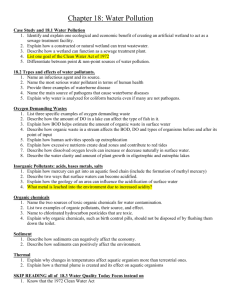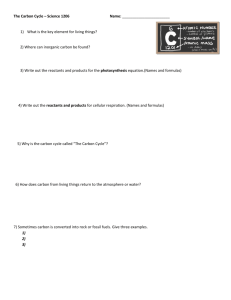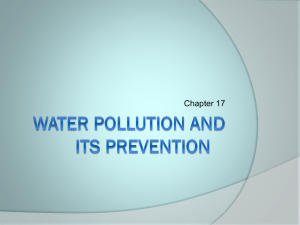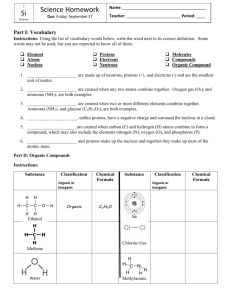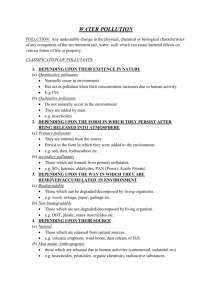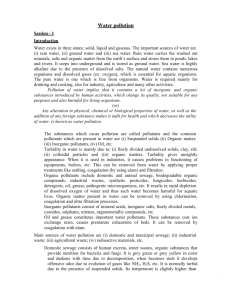Chapter Terms
advertisement
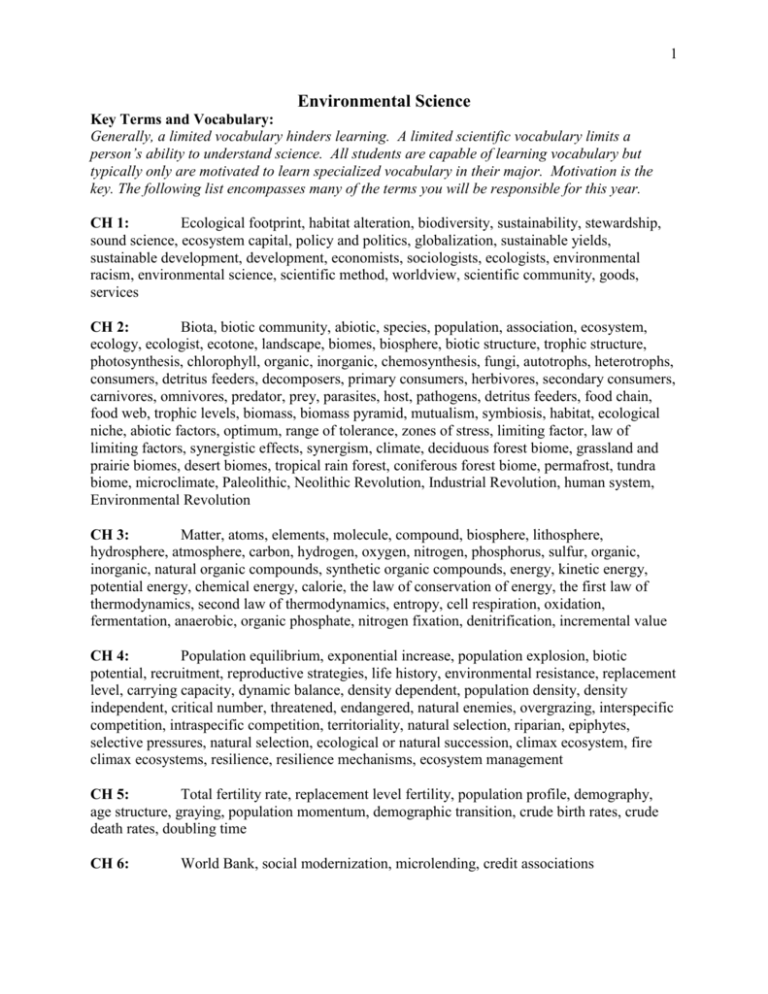
1 Environmental Science Key Terms and Vocabulary: Generally, a limited vocabulary hinders learning. A limited scientific vocabulary limits a person’s ability to understand science. All students are capable of learning vocabulary but typically only are motivated to learn specialized vocabulary in their major. Motivation is the key. The following list encompasses many of the terms you will be responsible for this year. CH 1: Ecological footprint, habitat alteration, biodiversity, sustainability, stewardship, sound science, ecosystem capital, policy and politics, globalization, sustainable yields, sustainable development, development, economists, sociologists, ecologists, environmental racism, environmental science, scientific method, worldview, scientific community, goods, services CH 2: Biota, biotic community, abiotic, species, population, association, ecosystem, ecology, ecologist, ecotone, landscape, biomes, biosphere, biotic structure, trophic structure, photosynthesis, chlorophyll, organic, inorganic, chemosynthesis, fungi, autotrophs, heterotrophs, consumers, detritus feeders, decomposers, primary consumers, herbivores, secondary consumers, carnivores, omnivores, predator, prey, parasites, host, pathogens, detritus feeders, food chain, food web, trophic levels, biomass, biomass pyramid, mutualism, symbiosis, habitat, ecological niche, abiotic factors, optimum, range of tolerance, zones of stress, limiting factor, law of limiting factors, synergistic effects, synergism, climate, deciduous forest biome, grassland and prairie biomes, desert biomes, tropical rain forest, coniferous forest biome, permafrost, tundra biome, microclimate, Paleolithic, Neolithic Revolution, Industrial Revolution, human system, Environmental Revolution CH 3: Matter, atoms, elements, molecule, compound, biosphere, lithosphere, hydrosphere, atmosphere, carbon, hydrogen, oxygen, nitrogen, phosphorus, sulfur, organic, inorganic, natural organic compounds, synthetic organic compounds, energy, kinetic energy, potential energy, chemical energy, calorie, the law of conservation of energy, the first law of thermodynamics, second law of thermodynamics, entropy, cell respiration, oxidation, fermentation, anaerobic, organic phosphate, nitrogen fixation, denitrification, incremental value CH 4: Population equilibrium, exponential increase, population explosion, biotic potential, recruitment, reproductive strategies, life history, environmental resistance, replacement level, carrying capacity, dynamic balance, density dependent, population density, density independent, critical number, threatened, endangered, natural enemies, overgrazing, interspecific competition, intraspecific competition, territoriality, natural selection, riparian, epiphytes, selective pressures, natural selection, ecological or natural succession, climax ecosystem, fire climax ecosystems, resilience, resilience mechanisms, ecosystem management CH 5: Total fertility rate, replacement level fertility, population profile, demography, age structure, graying, population momentum, demographic transition, crude birth rates, crude death rates, doubling time CH 6: World Bank, social modernization, microlending, credit associations 2 CH 7: Freshwater, hydrologic cycle, evaporation, water vapor, humidity, relative humidity, condensation, aerosols, Hadley cell, rain shadow, infiltration, runoff, infiltration-runoff ratio, watershed, surface waters, capillary water, evapotranspiration, percolation, gravitational water, groundwater, water table, aquifer, recharge area, seep, spring, nonconsumptive, consumptive, estuaries, land subsidence, sinkhole, saltwater intrusion, desalination, xeriscaping, gray water CH 8: Horizons, soil profile, O horizon, humus, A horizon, topsoil, E horizon, eluviation, B horizon, subsoil, C horizon, sand, silt, clay, soil texture, loam, workability, soil fertility, weathering, leaching, nutrient-holding or ion-exchange capacity, fertilizer, organic fertilizer, inorganic fertilizer, transpiration, infiltrate, water-holding capacity, evaporative water loss, soil aeration, compaction, pH, composting, castings, soil structure, mycorrhizae, mineralization, erosion, splash erosion, sheet erosion, gully erosion, desert pavement, desertification, overcultivation, no-till agriculture, low-till farming, contour strip cropping, shelterbelts, overgrazing, deforestation, sediments, flood irrigation, center-pivot irrigation, salinization CH 9: Green Revolution, subsistence farmers, Doulbly Green Revolution, precautionary principle, food security, family, nation, global community, malnutrition, undernourishment, Food Guide Pyramid, overnourishment, famine CH 10: Biota, biological wealth, biodiversity, intrinsic value, ecotourism, endangered species, threatened species, keystone species CH 11: Total allowable catch, individual quota, forests and woodlands, grasslands and savannas, croplands, wetlands, deserts and tundra, coastal ocean and bays, coral reefs, open oceans, natural goods, natural services, natural resources, renewable resource, conservation, preservation, consumptive use, productive use, maximum sustainable yield, carrying capacity, optimal population, total allowable catch (TAC), precautionary principle, common pool resource, commons, restoration ecology, silviculture, sustainable forest management, wilderness, national parks, national wildlife refuges, ecosystem management CH 12: Secondary energy source, primary energy source, electric generator, turbogenerator, conversion loss, thermal pollution, estimated reserves, oil fields, proven reserves, production, primary recovery, secondary or tertiary recovery, synthetic fuels, oil shale, oil sands, combined heat and power (CHP) or cogeneration CH 13: Fission, fusion isotopes, mass number, fission products, enrichment, moderator, fuel rods or elements, control rods, meltdown, radioisotopes, curies, radioactive emissions, radioactive wastes, sieverts, radioactive decay, half-life, reprocessing, active safety, passive safety, embrittlement, corrosion CH 14: Solar constant, flat-plate collectors, earth-sheltered housing, energy star, photovoltaic cell, PV cells, solar-trough, wind turbine, wind farms, electrolysis, fuel cells, geothermal energy, tidal barrage, ocean thermal-energy conversion, Renewable Portfolio 3 Standard, production tax credits, net metering, research and development, efficiency standards, building codes, tax incentives, combined heat and power (CHP), fuel economy (CAFE) standards, development of high efficiency vehicles, hybrid electric and fuel cell vehicles, carbon tax CH 15: Environment health, environment, hazards, risk, health, morbidity, mortality, epidemiology, underweight, chronic, acute, carcinogenic, toxicology, risk assessment, epidemiological study, animal testing, dose-response assessment, exposure assessment, risk management, risk perception, precautionary principle CH 16: Pests, agricultural pests, weeds, herbicides, pesticides, chemical treatment, ecological control, integrated pest management, first-generation pesticides, scale insects, secondgeneration pesticides, broad spectrum, persistent, resurgence, secondary pest outbreak, pesticide treadmill, bioaccumulation, biomagnification, bioconcentration, natural and biological control, cultural control, control by natural enemies, genetic control, natural chemical control, hormones, pheromones, juvenile hormone, ecdysone, economic threshold, insurance spraying, cosmetic spraying, field scouts, pest-loss insurance, organic food, Delaney clause, tolerances, prior informed consent CH 17: Hypoxic area or dead zone, eutrophication, pollutant, nonbiodegradable, point source, nonpoint source, pathogens, biochemical oxygen demand (BOD), inorganic chemicals, organic chemicals, bed load, National Recommended Water Quality Criteria, criteria maximum concentration (CMC), criterion continuous concentration (CCC), Drinking Water Standards and Health Advisories, Safe Drinking Water Act (SDWA), maximum contaminant levels (MCLs), National Pollution discharge Elimination System (NPDES), Total Maximum Daily Load (TMDL), benthic plants, submerged aquatic vegetation, emergent vegetation, oligotrophic, eutrophication, cultural eutrophication, phosphorus, nitrogen, best management practices (BMPs), raw sewage, storm drains, sanitary sewers, raw sewage or raw waste water, preliminary treatment, bar screen, grit chamber, primary treatment, primary clarifiers, raw sludge, secondary treatment, biological treatment, trickling-filter system, activated-sludge system, activated sludge, clarifier tank, biological nutrient removal (BNR), denitrification, anaerobic digestion, sludge digesters, biogas, treated sludge, biosolids, sludge cake, composting, windrows, pasteurized, Clean Water Act (CWA) of 1972, Clean Waster State Revolving Fund (SRF) CH 18: Municipal solid waste (MSW), landfill, LULU, NIMBY, NIMTOO, waste-toenergy, materials recovery facilities CH 19: Toxicology, acute, chronic, carcinogenic, dose response, exposure, hazardous material, ignitability, total product life cycle, Emergency Planning and Community Right-toKnow Act (EPCRA) of 1986, halogenated hydrocarbons, chlorinated hydrocarbons, organic chlorides, Stockholm Convention on Persistent Organic Pollutants, Resource Conservation and Recovery Act (RCRA), best-demonstrated available technologies (BDATs), secure landfill, midnight dumping, orphan sites, Safe Drinking Water Act of 1974, groundwater remediation, Comprehensive Environmental Response, Compensation and Liability Act of 1980, National Priorities List, bioremediation, phytoremediation, brownfields, Brownfield Act, underground storage tank (UST), discharge permit, Department of Transportation Regulations (DOT Regs), 4 Occupational Safety and Health Act (OSH Act of 1970), hazard communication standard or “worker’s right to know,” material safety data sheet (MSDS), Superfund Amendments and Reauthorization Act of 1986 (SARA), Toxic Substances Control Act of 1976 (TSCA), environmental justice, pollution control, pollution prevention green products, wet cleaning CH 20: Troposphere, tropopause, stratosphere, weather, climate, meteorology, convection currents, monsoons, proxies, isotopes, Milankovitch cycles, conveyor, radiative forcing, greenhouse gases (GHGs), planetary albedo, positive feedback, adaptation, mitigation, Precautionary Principle, polluter pays principle, equity principle, Framework Convention on Climate Change (FCCC), carbon credit trading, Global Climate Change Initiative, emissions intensity, Least Developed Countries Fund, Special Climate Change Fund, Scientific Assessment of Ozone Depletion: 2002, ozone shield, chlorofluorocarbons (CFCs), chlorine catalytic cycle, catalyst, Montreal Protocol CH 21: Air pollutants, hydroxyl radical OH), industrial smog, photochemical smog, temperature inversion, particulates, VOCs, CO, NOx, SO2, lead, air toxics, primary pollutants, secondary pollutants, O3, peroxyacetyl nitrates, sulfuric acid, nitric acid, nitrogen oxides, emissions, ambient concentrations, photochemical oxidants, acid deposition, acid, base, pH, acid precipitation, buffer, artifacts, Clean Air Act of 1970 (CAA), ambient standards, criteria pollutants, National Ambient Air Quality Standards, primary standard, Nations Emission Standards for Hazardous Air Pollutants (NESHAPs), command-and-control, Clean Air Act Amendments (CAAA), reasonably available control technology (RACT), catalytic converter, Energy Policy and Conservation Act of 1975, point source, area source, maximum achievable control technology (MACT) CH 22: Benefit-cost analysis, centrally planned economy, free market economy, land, labor, capital, ecological economists, economic production produced assets, natural capital, human resources, human capital, social capital, knowledge assets, Environmental Policy Act, Environmental Protection Agency, effectiveness, efficiency CH 23: Highway Trust Fund, exurban migration, exurbs, Intermodal Surface Transportation Efficiency Act (ISTEA), Transportation Equity Act for the Twenty-first Century (TEA-21), eroding or declining tax base, urban blight, urban decay, Slum Dwellers International (SDI), Sustainable Communities Network, Smart Communities Network, Chattanooga Venture, President’s Council on Sustainable Development


